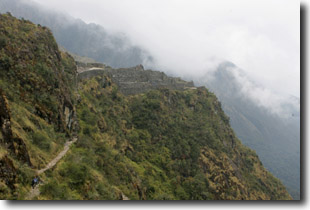 |
 |
The Actual Workout
 Whether a workout or the trek itself how we prepare the body for the effort it is about to perform and recover from it is the same. Indeed, many of us were taught incorrectly how to get ready for a workout. Stretching is not the first activity. Stretching a cold muscle accomplishes little and leads to injuries. Stretching has its place, but it’s later.
Whether a workout or the trek itself how we prepare the body for the effort it is about to perform and recover from it is the same. Indeed, many of us were taught incorrectly how to get ready for a workout. Stretching is not the first activity. Stretching a cold muscle accomplishes little and leads to injuries. Stretching has its place, but it’s later.
Instead, the first activity is to warm up the muscles and get blood flowing. This may be accomplished in a many ways. One simple way is to just simply walk slowly before starting to trek with your pack or at a normal pace.
Another approach is to perform a series of mild exercises that get blood flowing and increase your range of motion at the same time. Performing a few of these exercises in succession has a surprisingly significant impact upon the body.
Once warmed up you can perform the workout.
After the workout, stretch the entire body. Each major muscle group needs attention. Your continued walking injury free is greatly aided by re-elongating your muscles after a days hard marching.
If you have a few key areas that give you difficulty, once warmed up, it is sometimes helpful to add a few targeted stretches before you being your workout. This does not however take the place of stretching afterwards.
Break in Those Boots!
Ideally, wear the boots you plan to trek in for some portion of the training. I recommend at least a day a week early and a few days a week in the last month of training. This gives you plenty of time to ensure the boots fit properly. Poor fitting boots lead to blisters and lost toe nails. Both are devastating during a trek. Ill-fitted boots are the primary reason for lost toe nails. Keep in mind, boots have a mileage limit. It’s impossible to give a universal number applicable to all boots and people. However, a few hundred miles is probably a good average. Therefore, if you train by my prescribed method, if you wore your boots for the every step of the 500 miles of the 14 week program, you would probably require a new set of boots, which also have to be broken in.
In addition to wearing your boots, you should wear your pack and fill it to the approximate weight of your trek. Again once a week early and a few times a week later should ensure that your pack fits properly and you are comfortable with the weight you plan to carry.
